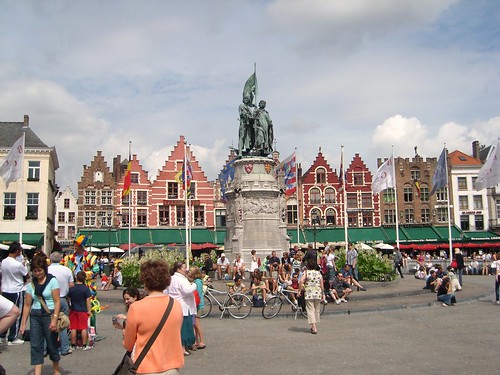
I was heading from the border towards Brussels, after a few kilometers I joined a towpath along a canal which was much better, all tarmaced. I grabbed a wheel from a lady out for her morning ride and together we managed a steady 30kmh despite the headwind.
At Herentals we left the canal and turned south along a very long, arrow straight, cycle path, I think called Broekhoven, that cuts right through the countryside. It was itself a traffic free route, but perhaps due to its directness it had to contend with roads crossing it at ninety degrees every few hundred meters and every time this occurred the path was broken by having to give way to cars and chicanes on either side of the road like this
View Larger Map
I can't imagine a similar design would have been permitted in the Netherlands, after going to the trouble of laying the bricks and installing a hump I'm not sure why they couldn't give priority to cyclists, these were generally very quiet roads.
As I approached Brussels eventually the cycle paths ran out and I was left with a two foot wide strip of advisory on-road lane. At this point I discovered that Belgian drivers are no better than their British counterparts, they pass close and the pass quickly. By the time I arrived in Brussels the number of cyclists I was seeing was approaching British levels, this Living Street was notable for its uniqueness

Brussels was on the whole not a nice place to be, drivers were aggressive, there were next to no cycle paths and they made the classic British mistake of providing infrastructure that was actively more dangerous then doing nothing, namely contraflow cycling where roads were far too narrow. For example...
View Larger Map
The sign says no entry except for cycles and this is by no means the narrowest of streets to have it, I think every one way street in the city allowed contra flow cycling but it was completely inappropriate for many of them. With no lane marking, parking on both sides and cars coming at you without slowing and only leaving a gap 2-3 feet wide it was rather treacherous. No, I didn't like Brussels. A surprising number of Bromptons around though.
The next day didn't improve much, the road to Gent was dreadful. I had picked up some mild saddle sores on Day 1 due to ill fitting shorts and the road to Gent provided mile after mile of seamed concrete, thousands of seams and I felt every single one of them.
View Larger Map
Gent saw some little improvement but not much I encountered these cycle streets, I think the sign says 'cars are guests'

But after cycling in the Netherlands this looks like a road full of cars with some red paint.
Arriving in Brugge the number of cyclists visibly increased and this was confirmed when I arrived at the station and noticed some bike parking

I know these exist in the Netherlands although I hadn't come across one, it was brilliant to see so many bikes in one place, I'd guess 2-3000. Not so good was the hotel, an Ibis and the only chain hotel of my visit, I hadn't even reached the desk and the guy was shaking his head saying I couldn't take my bike in. He suggested I leave it at the cycle park, so I returned there and went to the office, the lady behind the desk took one look at my rather expensive new bike and said 'You know there's no night security?', 'Oh rly?' thought I, that wasn't a chance I was willing to take. I rode into the town centre walked into a little hotel and asked if it was okay to stay with my bike in my room, no problem at all. So the Ibis turned out to be the only bike unfriendly hotel of the trip.
Brugge seemed to have a lot of cyclists despite a lack of infrastructure, I suppose the main roads mostly had cycle paths alongside and then in the heart of the city there weren't that many cars but most roads had nothing specifically to help cyclists. In the old town square there was a poster with one fascinating picture of how the square used to look...

There's a VW Scirrocco in there and an Opel Vectra which puts this sometime in the early nineties. They've got rid of the empty metal boxes and now it is full of people and bicycles, carriage rides, cafes and Christmas markets

The following day I arrived in Lille, France, for reasons I won't go into here I had to complete the tour on the train by taking the TGV to Paris. In France I felt straight away that despite there being very little infrastructure there was more acceptance of cycling, drivers left more room and my bike was drawing a lot more admiring glances from passers-by which was nice.
Paris is of course a very big city with a lot of traffic and I was definitely trying to 'keep my wits about me' and I admit I enjoyed feeling the adrenalin course through my veins again after days in the quiet countryside and towns. This was cycling as an extreme sport like white water rafting compared to canal boating, you know it's stupid and dangerous but it's also thrilling. Fortunately Parisian drivers are surprisingly patient with cyclists, no matter what lane position I took or what stupid move I pulled I seemed to be the only vehicle not being honked at.
So to sum up...
Belgium - a lot of infrastructure but almost all of a very poor quality and drivers don't like you at all.
France - very little infrastructure, but drivers seem considerate and avoid white lines.

No comments:
Post a Comment